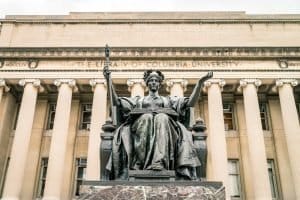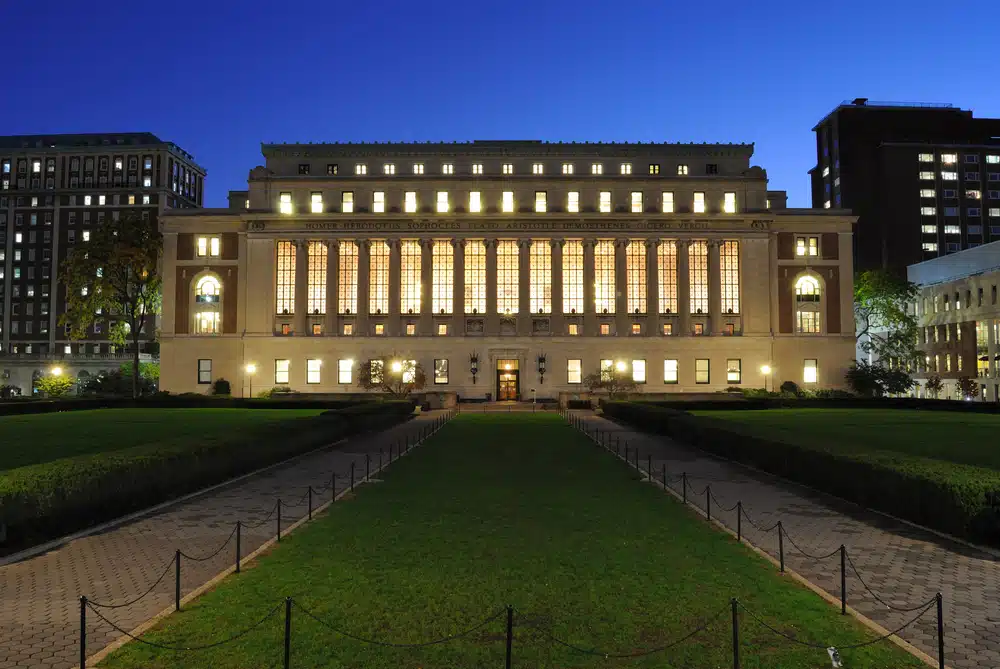3 Success Stories from Columbia University Admits
Ivy League schools are notorious among applicants for being difficult to get into. These eight high-level universities certainly live up to this reputation with admission rates hovering anywhere between 4% and 10% depending on the year and how many applications are sent in.
When compared to the average acceptance rate of universities across the country – which is around 68% – the exclusivity of these colleges is really put into perspective. Columbia is no exception to this rule. If you’ve set your sights on this excellent school, it can be inspiring to hear an explanation from successful admits how I got into Columbia University.

While hearing practical tips and strategies for increasing your chances of getting accepted are incredibly useful and important, there’s something unique about hearing from someone who was once in your position and succeeded at the exact goal you have.
You conceptually know it’s possible to get into the school, but hearing about the real experience and advice from someone who was accepted to Columbia can give you a new sense of confidence and a better perspective for approaching the application process. Here, we’ll take a look at some real success stories from Columbia University students.
How hard is it to get into Columbia?
Undoubtedly, one of the most common questions plaguing the minds of applicants to this prestigious Ivy League university on a daily basis is “how hard is it to get into Columbia?” For the class of 2024, Columbia’s acceptance rate was 6.1% which is actually higher than some previous years.
As we’ve discussed before, the admission rate for the average college in the US is 10x Columbia’s acceptance rate. Even among the other seven Ivy League schools, Columbia is one of the more selective, meaning it’s a highly competitive university. In order to greatly increase your chances of getting accepted, students will need to nail their application.

While the admission rate is the most obvious metric for determining the difficulty of getting into a school, there are some other stats that can help answer the question “how hard is it to get into Columbia?”
Of all the admitted students to the class of 2024, a whopping 95% performed in the top 18% of their classes in high school. Furthermore, the middle 50% of successful applicants had an SAT score range of 1500 and 1600. This translates to a 34 and 35 on the ACT. Clearly, Columbia attracts some of the best and brightest minds from not just all 50 states but from many countries around the world.
While it’s easy to get hung up on these admissions statistics, you shouldn’t let them weigh down on you. They’re only helpful for determining what kind of competition you’re going up against when applying to Columbia.

Although the acceptance rate can be daunting, it’s a great tool for setting realistic expectations while also lighting a fire under you to boost your determination. Once you get an accurate picture of how hard it is to be accepted to Columbia, you should focus all of your attention on increasing your chances of getting admitted.
Does applying to Columbia’s early decision make a difference?
Like many universities, Columbia has two application timelines, giving applicants more than one choice. While the vast majority stick with the standard application timeline, some opt for the alternative early decision timeline – also known as early admission for some schools.
Although you have to send in your application and all of the required documents a few months earlier than normal, there is an advantage to applying to Columbia’s early decision that many students don’t know about. This timeline actually has a higher acceptance rate than the standard application process.

Sounds too good to be true, right? Well, fortunately for all applicants, it’s 100% true! For the class of 2024, a total of 4.318 students applied to Columbia’s early decision, and exactly 650 got accepted. That comes out to be a 15.05% acceptance rate. As we mentioned before, the standard Columbia acceptance rate is 6.1%.
This means that early admission has an admission rate that’s more than double that of the standard application timeline. So, why doesn’t everyone apply early? Columbia’s early decision is binding, meaning students are expected to enroll immediately and withdraw applications from other schools.
As a result of this expectation, we only advise early decisions for students who are completely confident that Columbia University is their number-one school choice and that – if accepted – they won’t hesitate to enroll. If you’re still stuck deciding between a few schools, it’s recommendable to apply during the normal application timeline so that you’re not beholden to a binding rule.
3 success stories students from accepted to Columbia
Success Story #1
“Throughout last summer, one of my closest friends and I worked on our Common App together. I would write essays, and he would look over them, and vice versa. He loved Columbia and decided he wanted to ED.
He had similar stats to most accepted students: 4.0 and an ACT score in the mid-50%. He had a few leadership roles, was an excellent XC runner (he won’t be running at Columbia as of now), and volunteered in his community. So, he was similar to most applicants.
However, I believe his personal statement and Columbia-specific essays made him stand out. For those of you who don’t know, Columbia has several essays you must write in order for your application to be complete. Over the course of 3–4 months, he wrote, tweaked, and asked many people to review his work. His essays were grammatically spotless.
Additionally, the content of his essays was so intriguing. I couldn’t help but smile as I read them. His description through the use of a high-level vocabulary was second to none. He was able to use his writing skills to paint an awesome picture of himself and show the admissions officers who he was and what he could bring to Columbia.
So, in conclusion, if you aren’t an international award winner or whatever, focus on Columbia’s essays. My friend didn’t have the highest ACT or most awards. But, he did have a writing ability that portrayed the real him. He was unafraid to voice his thoughts on controversial issues. He was upfront, real, and fascinating to the admissions officers.
Don’t blow off your writing/English classes. They may very well help you get into the school of your dreams.”
Success Story #2
“Getting into any top college requires both having the necessary statistics (good marks, SAT scores), and some evidence of talent, doggedness, or another outstanding characteristic, that makes the school’s admissions officers think that you being an alumnus of their school will reflect well on them.
I think my high school extracurricular activities and marks/scores showed some aptitude for science. However, I think it is very important to show that you align well with the school’s culture. Most competitive schools have some sort of “Why X” essays, or essays that aim to understand your personality. In one of those – the favorite book essay – I wrote about a personal dilemma I had with the personal distress I felt after hearing anti-immigrant rhetoric and my belief in the freedom of speech which had been highlighted by a specific novel I had read.
Columbia’s president, Lee Bollinger, is quite keen on free speech, and as a whole, the university prides itself on its intellectualism – students in the college are required to go through an extensive core of classic literature and philosophy, among other subjects. So in retrospect, I think that I showed that I would be a good fit. Ironically, I did not like Columbia when I first visited, but still ended up attending, and am very grateful that I did.
College applications are often stressful, but they are a good opportunity to reflect on topics that are meaningful to you and writing honestly about them is a good tactic. Schools that like who you are will offer you admission, and there’s a good chance that you will be at least intellectually fulfilled there.”
- Ankita Saxena former student at Columbia University
Success Story #3
“I applied to Columbia’s regular decision in the winter of 2009/2010. Because I’m really shitty with deadlines, I applied on January 1st, the application deadline, at around 8 pm using Columbia’s own application system (this was the the year before they went on the Common App). This was coming off a couple all-nighters finishing my application essays for other schools which were due 11:59 pm the night before. I submitted my Stanford app with seconds to spare. I say this with all my heart, don’t do what I did.
For my personal statement, I used the same as I used for the Common App. The content of my essay had nothing to do with anything else in my application. I did not mention any of my extracurriculars or academics. I went the route of emotional honesty and described one of my major flaws. I wrote about my inability to express my deeper emotions out of my crippling fear of judgment by others, and the psychological toll it’s taken (at least until that point in my life).
I also mixed in how I’ve used humor to deflect/obscure any attempts to be truly emotionally genuine, and how I’ve grown by learning to use composing music as a means of expressing deeper feelings. It was a very *me* essay. It was a statement of my perception of myself, and I imagine it went hand-in-hand with my recommendation letters, which likely portrayed me as the (hopefully) lovable class clown that I was in high school.
My supplement was much more subdued. I simply wrote about the Core Curriculum and how it fits with my intellectual values. I also mentioned some specifics about the physics department and how it fits with my interests in the subject (I majored in physics, and I made it abundantly clear on my application that it was my intention to do so). I didn’t care to write about NYC, because that really wasn’t one of the major reasons why I was applying.
To answer your final question, it was absolutely worth it. Attending Columbia shaped me into the man that I am today, for better or worse. The experiences that I had there will stay with me for life.”
- Manik Uppal former student at Columbia
Write your own “How I got into Columbia University” story
If you’re reading these success stories thinking “I wish this was me!”, we’ve got some excellent news: it can be you! How do we know? Well, AdmissionSight has helped countless students just like you exceed their own expectations by getting into some of the best schools in the university, including Columbia.

In fact, 75% of the students we work with get accepted into an Ivy League school or top 10 universities. How do we do it? We offer a variety of custom-tailored services designed to dramatically improve your application, giving you a better chance of catching the attention of admissions officers.
Need help getting stellar letters of recommendation from your teachers or high school counselors? We’ve got you covered. Looking for an awesome summer program that’s both intriguing and relevant to your studies? We can help you with that too! Want to participate in an academic competition?
Our team can provide you some great suggestions. AdmissionSight offers a number of other services specifically geared to help students increase their chances of getting into the university of their dreams. Feel free to contact us for a free consultation to learn more about what we offer.





































